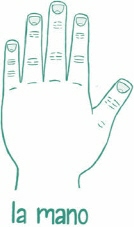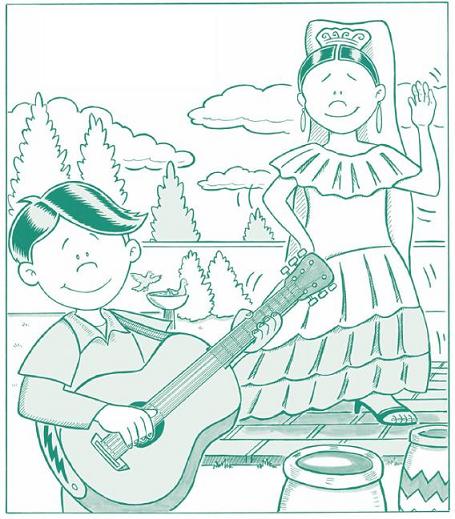
CHAPTER 3
People—La gente

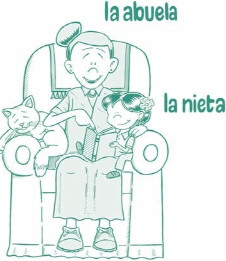
Consejo
IMPORTANT TIP
My Family—Mi familia
Now it’s time to talk about family! Since you live with your family, you probably talk with them often and spend lots of time together. Perhaps your parents help you with your homework after school and take you to the park when the weather is nice. This chapter will teach you all you need to know to talk with your family in Spanish!
Every family is different. Some children live with their mother and father, while others only have one parent or live with a relative. The Spanish word for father is el padre, and the Spanish word for mother is la madre. Or you can call them Papá (dad) and Mamá (mom). Here are the Spanish words for other family members:
| English | Spanish |
| grandfather | el abuelo |
| grandmother | la abuela |
| husband | el esposo |
| wife | la esposa |
| uncle | el tío |
| aunt | la tía |
| brother | el hermano |
| sister | la hermana |
| boy cousin | el primo |
| girl cousin | la prima |
| nephew | el sobrino |
| niece | la sobrina |
| son | el hijo |
| daughter | la hija |
| grandson | el nieto |
| granddaughter | la nieta |
Okay, it’s time to practice these new words and see if you can remember what they mean. In the following section you’ll be given a Spanish word for a family member. In the blank space, write the name of that person (or one of those people) in your family. So, for example, if you have a cousin named Michael, your response would look like this:
| el primo | Michael |
Now try some on your own. If there is no one in your family with one of these titles, then just leave the space blank.
| el tío | ___________________________________ |
| la abuela | ___________________________________ |
| la hermana | ___________________________________ |
| el abuelo | ___________________________________ |
| la prima | ___________________________________ |
| el hermano | ___________________________________ |
| la tía | ___________________________________ |
When you’re talking about your family, there are a few other words you need to know. First is the verb tener, which means “to have.” Tengo means “I have” and tienes means “you have.” So you can ask your friend ¿Cuántos hermanos y hermanas tienes? (How many brothers and sisters do you have?) and your friend might answer Tengo dos hermanos y una hermana. Now, answer this question about yourself: ¿Cuántos hermanos y hermanas tienes? Don’t forget to write the numbers in Spanish!
Yo tengo ___________ hermanos y _____________ hermanas.
The other useful words are “my” and “your.” There are two words for each of those in Spanish. If you’re talking about just one family member, you would use mi (my) or tu (your): mi padre, mi madre (my father, my mother), tu padre, tu madre (your father, your mother). If you’re talking about more than one, you’ll use mis (my) or tus (your): mis hermanos, mis primos (my brothers, my cousins), tus hermanos, tus primos (your brothers, your cousins).
Now you can talk to and about your family in Spanish! See what you can remember and go practice your new words with a parent or friend.
¡CUIDADO!
Mistake to Avoid
The Spanish word for “people” is la gente. If you want to say “one person,” that would be una persona. And remember: The word persona is always feminine, whether that person is a man or a woman. So, for example, tu padre (your father) is una persona, too!
¿Cómo?—
Say What?
More People—Más gente
Of course, there are lots more people in the world than just the ones in your family. Here are some other Spanish people words you should know:
| English | Spanish |
| baby boy | un niño |
| baby girl | una niña |
| boy | un chico |
| un muchacho | |
| girl | una chica |
| una muchacha | |
| teenage boy | un joven |
| teenage girl | una joven |
| man | un hombre |
| woman | una mujer |
| boyfriend | un novio |
| girlfriend | una novia |
In English, there are a lot of words for people that are the same whether the person is a boy or a girl. But in Spanish, there are two slightly different words for most people. Here are some common people words in English and their Spanish translations:
| English | Spanish (male) | Spanish (female) |
| neighbor | un vecino | una vecina |
| teacher | un profesor | una profesora |
| student | un estudiante | una estudiante |
| friend | un amigo | una amiga |
| my best friend | mi mejor amigo | mi mejor amiga |
| enemy | un enemigo | una enemiga |
| driver | un conductor | una conductora |
| passenger | un pasajero | una pasajera |
Descriptions and Personality—
Descripciones y personalidad
Now that you know what to call all of the different people you know, you can describe them. To ask “What is he or she like?” you can say ¿Cómo es? or ¿Qué tal es? In English, you might say, “He is tall” or “She is young.” Here are some of these answers in Spanish:
| English | Spanish |
| I am… | Yo soy… |
| He is... | Él es... |
| She is… | Ella es… |
| tall | alto |
| short | bajo |
| fat | gordo |
| thin | delgado |
| young | joven |
| old | viejo |
| good-looking | guapo |
| ugly | feo |
For example, Él es bajo y delgado means “He is short and thin.” But what if you’re describing a girl? In this case, you might need to change the ending of the word from o to a. For example, a tall girl is alta, and a pretty girl is guapa. The only word in this list that this doesn’t work for is joven, which remains the same for a boy or a girl.
Now try describing yourself! For example:
| I am young. | Yo soy joven. |
Fill in the blanks to complete a sentence describing yourself:
Yo soy _________________ y _________________.
In English, the adjective (the describing word) comes before the noun; but it’s the opposite in Spanish. When you speak Spanish, be sure to say the adjective after the noun.
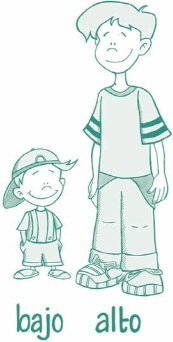
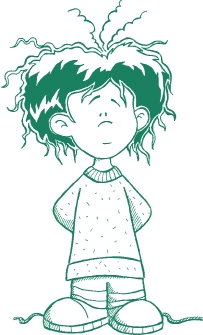
So, for example, if a person has blue eyes, you would say she has ojos azules (eyes blue). To form a complete sentence, start with él tiene (he has) or ella tiene (she has), then ojos (eyes), then the color. Here are some examples:
| English | Spanish |
| He has blue eyes. | Él tiene ojos azules. |
| She has green eyes. | Ella tiene ojos verdes. |
| Juan has gray eyes. | Juan tiene ojos grises. |
| Ana has brown eyes. | Ana tiene ojos castaños. |
When you talk about someone’s hair, it’s just the same: él tiene or ella tiene, plus cabello or pelo (hair), and then the color or other description word. The words pelo and cabello both mean hair, so you can use whichever one you want. Here are some hair descriptions you can use:
| English | Spanish |
| dark hair | cabello/pelo oscuro |
| black hair | cabello/pelo negro |
| brown hair | cabello/pelo castaño |
| red hair | cabello/pelo rojo |
| blond hair | cabello/pelo rubio |
| straight hair | cabello/pelo liso |
| curly hair | cabello/pelo rizado |
| wavy hair | cabello/pelo ondulado |
| short hair | cabello/pelo corto |
| long hair | cabello/pelo largo |
What type of hair do you have? Qué tipo de pelo tienes? Fill in your answer here:
| Yo tengo pelo | ________________________________. |
Two other words you might want to describe someone are pecas (freckles) and hoyuelos (dimples). For example:
| English | Spanish |
| He has freckles. | Él tiene pecas. |
| She has dimples. | Ella tiene hoyuelos. |
Now you know how to describe what everyone looks like, but what about their personality? For these descriptions, you’ll use Él es or Ella es, plus the describing word. For the words that end in o, remember to change it to a for girls. If it doesn’t end in o, then it’s the same for boys and girls. Here are some adjectives you might use:
| English | Spanish |
| affectionate | afectuoso |
| boring | aburrido |
| brave | valiente |
| friendly | amistoso |
| funny | divertido |
| impatient | impaciente |
| interesting | interesante |
| kind | amable |
| lazy | perezoso |
| mean | mezquino |
| nice | simpático |
| outgoing | abierto |
| patient | paciente |
| playful | guasón |
| serious | serio |
| shy | tímido |
| smart | inteligente |
| snobbish | esnob |
| strong | fuerte |
| studious | estudioso |
| stupid | estúpido |
| weak | débil |
Do you have an affectionate friend (un amigo afectuoso)? An interesting aunt (una tía interesante)? Fill in the following blanks to complete sentences describing yourself and your family members. For yourself, you’re going to use Yo soy again, which means I am. If you need to, refer back to the beginning of the chapter to review the Spanish words for different family members.
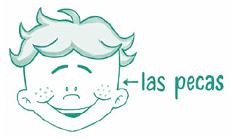
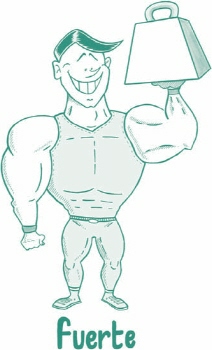
Consejo
IMPORTANT TIP
Yo soy _________________ y _________________.
Mi padre es _________________ y _________________.
Mi madre es _________________ y _________________.
Mi hermano es _________________ y _________________.
Mi hermana es _________________ y _________________.
Mi abuelo es _________________ y _________________.
Mi abuela es _________________ y _________________.
Mi tío es _________________ y _________________.
Mi tía es _________________ y _________________.
Mi primo es _________________ y _________________.
Mi prima es _________________ y _________________.
Feelings—Sentimientos
So now you know how to describe what people look like and what kind of personality they have, but what about how they feel? People’s feelings change all the time, so you’ll need to learn some new vocabulary to keep up with them.
For most feelings, you’ll use the verb estar (to be). To say “I am” in Spanish, say yo estoy. To say “you are,” say tú eres. Now, just add one of the following feelings words and you’ve got yourself a sentence!
| English | Spanish |
| angry | enojado |
| annoyed | enfadado |
| bored | aburrido |
| depressed | deprimido |
| dizzy | mareado |
| embarrassed | avergonzado |
| excited | entusiasmado |
| happy | feliz, alegre |
| jealous | celoso |
| nervous | inquieto |
| offended | ofendido |
| sad | triste |
| sick | enfermo |
| tired | cansado |
When you feel bored, you can say Estoy aburrido. When you feel happy, you can say Estoy feliz. These are emotional feelings, which means they describe how your mind feels. For physical feelings (the way your body feels) you can’t use estar; you need a different verb. This verb is tener (to have). In English, you say “I am hungry” or “I am cold,” but in Spanish what you literally have to say is Tengo hambre (I have hunger) and Tengo frío (I have cold.) This may seem a little strange because of the way you are used to using “to have” in English. Don’t worry; it just takes some getting used to.
To create a sentence using tener, start with yo tengo (I am) or tú tienes (you are). Then, add one of the following:
| English | Spanish |
| hungry | hambre |
| thirsty | sed |
| hot | calor |
| cold | frío |
To tell someone that you’re hungry, you say, Tengo hambre. To ask someone if he or she is hot, just ask ¿Tienes calor? Easy, right? Remember: Practice makes perfect!
¡CUIDADO!
Mistake to Avoid
Even though you should use estar with most emotional feeling words (like happy or sad) and tener with most physical feeling words (like hot or cold), some words don’t follow these rules. For example, to say “I am scared” (an emotional feeling), you would say Tengo miedo.
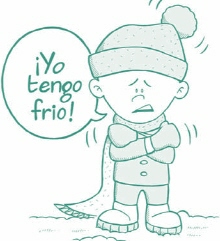
Consejo
IMPORTANT TIP
Parts of the Body—Partes del cuerpo
Now it’s time to learn how to talk about parts of your body. From your head to your toes, it’s fun to describe all your parts in Spanish. Here are some good words to know:
| English | Spanish |
| hair | el cabello, el pelo |
| head | la cabeza |
| face | la cara |
| eye | el ojo |
| nose | la nariz |
| cheek | la mejilla |
| mouth | la boca |
| lip | el labio |
| tooth | el diente |
| ear | la oreja |
| English | Spanish |
| neck | el cuello |
| chest | el pecho |
| back | la espalda |
| stomach | el estómago |
| arm | el brazo |
| shoulder | el hombro |
| elbow | el codo |
| wrist | la muñeca |
| hand | la mano |
| finger | el dedo |
| fingernail, toenail | la uña |
| thumb | el pulgar |
| leg | la pierna |
| knee | la rodilla |
| ankle | el tobillo |
| foot | el pie |
| toe | el dedo |
